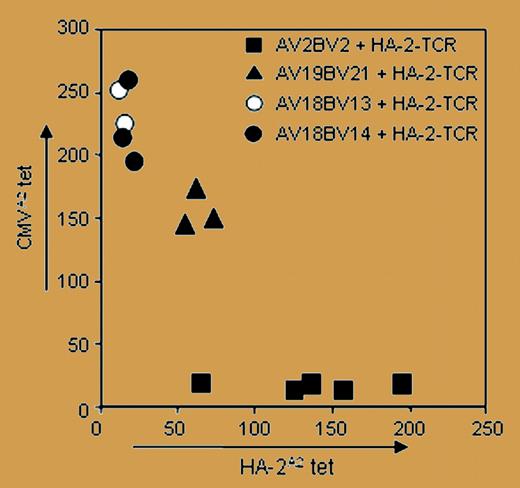In this issue of Blood, Heemskerk and colleagues provide new insights into TCR chain pairing that will aid in the development of therapeutic T cells with new antigen specificities.
T cells once were thought to have a single-antigen specificity encoded by a unique T-cell receptor (TCR). However, many naturally circulating T cells are not allelically excluded at their TCRα locus.1 When both α alleles functionally rearrange, T cells can express 2 different αβ receptor heterodimers. Dual-receptor expression may allow T cells expressing autoreactive receptors to avoid negative selection in the thymus, and may play a role in autoimmune diseases.2
The problem of polygamous pairing between TCRα and β chains may become even more complex in adoptive immunotherapy systems. Cells that target a specific antigen can be sparse, with natural frequencies of 1 in 10 000 or less. Immune tolerance may further leavespecificity holes in the T-cell repertoire.3 Acquiring adequate numbers of T cells specific for a desired antigen for immunotherapy is thus a significant challenge. Transgenically introducing specific TCRs into T cells for adoptive immunotherapy is one solution.4 Introduced TCRs can be derived from endogenous receptors or engineered to provide specificities or affinities not naturally present. Using retroviral vectors, it is possible to routinely transduce 15% to 50% of T lymphocytes, permitting the rapid generation of specific T cells. Indeed, the clinical potential of immunotherapy using T cells expressing introduced TCRs has recently been illustrated in patients with melanoma.5 However, introducing an additional α and β chain into a T cell also increases the number of TCRs it can express. Transduced T cells with a single endogenous α chain can express 4 different receptors; T cells with 2 endogenous α chains can express up to 6. The impact of these additional receptors is unknown and a concern.
Expression of a transgenic HA-2 TCR in 4 CMV-specific T-cell clones with different endogenous TCRα and β chains measured by antigen-tetramer staining. Levels of expression of endogenous versus transgenic TCRs vary with each clone. See the complete figure in the article on page 235.
Expression of a transgenic HA-2 TCR in 4 CMV-specific T-cell clones with different endogenous TCRα and β chains measured by antigen-tetramer staining. Levels of expression of endogenous versus transgenic TCRs vary with each clone. See the complete figure in the article on page 235.
Heemskerk and colleagues have studied this by looking at chain pairing between a menagerie of introduced minor histocompatibility antigen (HA)–specific receptors and endogenous TCRs. They show that TCR pairing does not occur through random association, but rather is guided by intrinsic properties of the TCR chains. Two effects are apparent. First, some TCRα and β pairs associate particularly well and limit the formation of chimeric receptors in which introduced and endogenous receptor chains pair. This is an important finding that suggests it may be possible to identify TCRs less likely to form polygamous associations with endogenous receptors. Second, receptors compete for cell-surface expression, potentially through competition for the signaling CD3 chains of the TCR; some receptor heterodimers are better at this than others.
These results provide a starting point for analyzing how receptor pairing affects TCR cell surface expression. The implication is that TCRs used for adoptive immunotherapy must be assessed not only for their antigen specificity but also for their associative properties. Identifying optimal TCR remains empiric. However, a basis now exists for studying the biologic properties that govern TCR competition for association and for expression. Mutational and structural analyses of TCRs using systems like that presented by Heemskerk and colleagues can provide a better understanding of these biologic properties. This may permit the development of improved TCRs for use in adoptive immunotherapy.
The author declares no competing financial interests. ▪


This feature is available to Subscribers Only
Sign In or Create an Account Close Modal